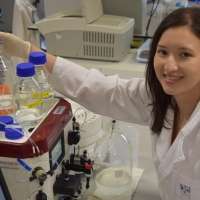Protein doppelgangers are long-lost cousins

A 60-year-old mystery has been solved by biochemists at The University of Western Australia investigating the origin of a type of digestion-inhibiting proteins thought only to exist in two plant families that contain the important legume and cereal crops.
A gene for the 'missing link' between the two plant families was found in the primitive spike moss Selaginella, revealing the inhibitor proteins as having truly ancient origins, according to lead researcher Dr Joshua Mylne, principal investigator with UWA's School of Molecular Sciences and affiliated with the national ARC Centre of Excellence in Plant Energy Biology.
Bowman-Birk Inhibitors or BBIs were one of the first plant proteins to be subjected to biochemical studies and defined the mechanisms for protein-digesting enzymes and proteins that inhibit those enzymes.
The researchers, from UWA and La Trobe University in Melbourne, used computer-aided searches and next-generation massively parallel sequencing to discover the origins of BBIs.
BBIs are abundant proteins so far thought only to exist in the important legume and cereal plant families. This study published overnight in the international journal Plant Cell resolves the long standing mystery how distantly related families came to contain the same type of protein.
"When two things look the same, they can be related or through evolution have converged to appear the same," Dr Mylne said.
"The eyes from a human and an octopus look similar, but arose independently and are differently wired.
"For BBIs, both convergence and being related were possible."
Lead author and UWA PhD student Amy James said the proteins in legumes and cereals turned out to be long lost cousins; that is they had a common ancestor.
"This discovery was serendipitous," Ms James said.
"We were actually looking for a very short sequence that blocks digestive enzymes. Some BBIs have this sequence, but so do other inhibitors we were working on.
"This search revealed a sequence in the dinosaur-age plant Selaginella that we immediately recognised as a BBI despite all its other differences.
"I produced the Selaginella protein in bacteria and showed that it worked exactly the same as BBIs.
This finding that BBIs were ancient meant they should exist in more than just legumes and cereals.
"When we looked hard enough for them elsewhere, sure enough, we started to find BBI sequences in many places such as bananas."
Dr Mylne said the researchers were curious to know why BBIs were so abundant in legumes and cereals, but appear to have faded into obscurity elsewhere.
"Is it just a coincidence that these molecules are so abundant in the plant families we choose most of our crops from," he said.
The study "Evidence for ancient origins of Bowman-Birk inhibitors from Selaginella moellendorffii" was supported by the Australian Research Council.
More information: Amy Midori James et al. Evidence for Ancient Origins of Bowman-Birk Inhibitors from Selaginella moellendorffii, The Plant Cell (2017). DOI: 10.1105/tpc.16.00831
Journal information: Plant Cell
Provided by University of Western Australia





















